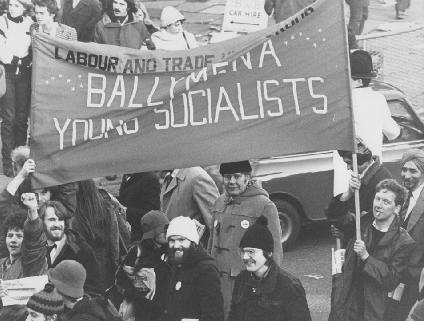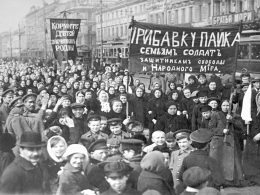By Michael Cleary
The history of Northern Ireland is portrayed as a history of two sectarian blocs in endless conflict. There is another side to this history, however, one which is often hidden and denied. The workers’ movement has a rich and proud record of opposition to sectarianism, taking united action on many occasions in order to prevent sectarian violence from spiralling out of control. Throughout the ‘Troubles’ – the heightened conflict between Republican/Catholics and Loyalist/Protestants from the late 1960s to late 1990s – the majority of workers remained united in their trade unions. Not once has a strike been defeated by sectarianism. This is the forgotten history of the Troubles, not even hinted at in the hundreds of books written over the years. Scandalously, the mini-industry of publications spawned by the ‘peace process’ make no mention of the role of the organised working class, or even note in passing the repeated huge demonstrations of the 1990s.
It is in the interests of sectarian politicians that much of the day-to-day politics in Northern Ireland is dominated by arguments and disagreement over sectarian issues, such as the routes of disputed parades and the flying of the Union flag of the United Kingdom. The same politicians argue over ‘the past’, especially the events since the outbreak of the Troubles. The sectarian parties have a sectarian view of the past just as they do of the present. They seek to proclaim themselves as the best representatives of ‘their’ community in the present. And they defend their positions from the past in order to bolster their positions today.
Class-conscious activists have a duty to counter this view, and to act as the collective memory of the working class. It is important to preserve the working-class history of the North, in particular the highpoints of class struggle when the working class moved in unity on social or industrial issues, or in opposition to sectarianism. It is vital that we do so precisely because the layers of activists who retain the traditions of the past, or who learn about these traditions today, are the key to the future.
August 1969
The Troubles began in the tumultuous events of late 1968 and in particular the street violence in the summer of 1969. While the violence and arson of August 1969 have gone down in history, few remember that, although severe, it was contained to relatively few areas. There were many working-class areas, including some which were to see sharp sectarian conflict in the following years, where peace prevailed. The reason for this is that trade union and community activists, and members of left political parties, came onto the streets in joint patrols to maintain calm and to prevent sectarian elements from stoking up trouble.
Of decisive importance was the organised trade union intervention in key workplaces, in particular in the Harland and Wolff shipyard where a mass meeting of 8,000 workers voted against any attempt to foment sectarian division. Sandy Scott, the senior shop steward in the yard, and a member of the Northern Ireland Labour Party (NILP), moved a motion which was passed by a show of hands: “This mass meeting of shipyard workers calls on the people of Northern Ireland for the immediate restoration of peace throughout the community. We recognise that the continuation of the present civil disorder can end only in economic disaster. We appeal to all responsible people to join with us in giving a lead to break the cycle of mutual recrimination arising from day-to-day incidents”. (Quoted in David Bleakley, Peace in Ulster, The Alden Press, Oxford, 1972) The example of the shipyard was hugely important as Harland and Wolff had seen mass expulsions of Catholics, and of socialists and active trade unionists, on several occasions over the previous decades.
There were, of course, weaknesses in the stance taken by trade union activists. The leaders of the unions and the NILP had refused to put their organisations at the forefront of the struggle for civil rights. Simple calls for peace were important but insufficient and meant that the labour movement did not offer a clear class alternative, especially to the many thousands of Catholic youth who were seeking a way forward.
Labour movement activists also took the lead in local communities. In working-class streets there was what amounted to a mass movement to prevent conflict. Evidence given to the Scarman Tribunal, established by the government in the aftermath of the August events, illustrates just how the violence was prevented from spreading. It explained that the area between the Catholic Markets and the Protestant Sandy Row in South Belfast remained “quiet” in August. In fact, it was noted that relationships between residents were “very good”. Two peace committees were created, one in the Markets and one in Sandy Row, and they “collaborated well and worked together to maintain peace”. Elsewhere in South Belfast barricades went up in the Donegal Road area, but they “were manned by both Catholics and Protestants working in harmony”.
North Belfast was the area worst affected in the years of violence from 1971 onwards but, while August 1969 saw a “heightening of tension”, there was no violence. Barricades did go up on the interface between the Catholic New Lodge and the Protestant Tiger’s Bay area but “serious disturbance” was avoided and co-operation between the various Protestant and Catholic streets helped to take the “whole explosive tension out of the area”.
The interface between the Catholic Short Strand and the Protestant Lower Newtownards Road in East Belfast saw “dangerously high” tension, but “no clashes between civilians” occurred. A street committee in the Short Strand worked with the mainly Protestant East Belfast Peace Committee to ensure that this was the case, and they were successful in this even though police numbers in the area were “at the barest minimum” as the force was redeployed to other areas of Belfast and to Derry. It was not the introduction of relatively small numbers of troops into limited geographical areas which turned the tide of violence but the organised working class. (All quotes: Riotous Assemblies, Rebels, Riots and Revolts in Ireland, edited by William Sheehan and Maura Cronin, Mercier Press, 2011)
Such action at street level was made possible because there were class-conscious shop stewards living in practically every working-class street in Belfast at the time. By the late 1960s a significant shop stewards layer had developed in England, Scotland and Wales, especially in the engineering industry. This was the case in Northern Ireland too. As a consequence of the long-term post-war upswing in the economy these activists were confident both of squeezing concessions from the employers but also in their ability to act without necessarily seeking the authorisation of the full-time apparatus of the unions. This independence was a key factor in the relative success of the workers’ movement in combating sectarianism in 1969 while, today, a lack of confidence to act independently holds back the movement on both industrial issues and in the task of checking sectarian violence. The militancy and combativeness of trade union activists are and were organically linked to the class consciousness of the wider layers of working-class people, and the level of consciousness is much lower today.
There was also a political element to the opposition to the conflict. Many thousands of working-class activists were influenced by the NILP and other left parties. In the 1960s, the NILP, for all its weaknesses, had a mass base. In 1962, it gained 62,175 votes in Belfast, compared to 67,350 for the Unionist candidates. This represented 26% of the votes cast. The total left vote in Belfast was 32.8% if other small left parties are added. Even after the events of August 1969, the NILP still had mass support and achieved 105,759 votes in the 1970 general election. The idea that workers could be united both industrially and politically was not seen as utopian but was a living reality.
Better Life for All Campaign
When sectarian forces organised and moved onto the streets they at first met intense resistance from the best labour movement activists. However, the lack of a class-conscious leadership in either the trade unions or the NILP meant that, ultimately, this anti-sectarian bulwark was breached. Events spiralled out of control in the early 1970s and within five years over 1,000 were dead. There were sporadic walkouts and protests by workers during this period, often provoked by the worst excesses of the paramilitaries and the state but, such was the degree that the class had been set back, it was some years before a more generalised movement developed.
In 1975-76 there was an upsurge in sectarian killings. This reached a horrific peak in January 1976 when Loyalists shot dead six Catholics in South Armagh, and the Irish Republican Army (IRA) killed ten Protestant workers at Kingsmills. In response, trade union activists called a series of strikes and protests through the trades councils in Newry, Derry and Craigavon which brought tens of thousands onto the streets. A determined lead quickly demonstrated that the mass of the working class felt only revulsion at the killings.
There was a genuine opportunity to deal a fatal blow to the sectarians on both sides and to build a socialist political alternative. However, this opportunity was criminally squandered by the official leaders of the trade union movement in the Northern Ireland Committee of the Irish Congress of Trade Unions (NIC-ICTU). Instead, they created the toothless Better Life for All Campaign, which diverted the movement away from determined strike action and from political action.
To an extent the energy of this movement was re-channelled by the peace movement of the second half of 1976. Tens of thousands of working-class people took part in the demonstrations organised by the Peace People, although this movement quickly lost momentum as its leadership was dominated by individuals who ignored economic and social issues and resolutely refused to take up the issue of state violence and repression. Neither the trade union actions nor the huge rallies organised by the Peace People continued for long but there was a dramatic decrease in sectarian killings between 1978 and 1985. There is no doubt that this was in large part as a result of the movements of 1975-76.
Walkouts and strikes
In 1985 the Anglo-Irish Agreement was signed by the British prime minister, Margaret Thatcher, and the Irish Taoiseach, Garret FitzGerald. The result was a resurgence in sectarian tension and division. The late 1980s and early 1990s again saw a succession of united mass movements of Catholic and Protestant workers against sectarian threats and killings. In many instances these movements were organised by members of the Socialist Party (then the Militant). In others they were inspired by the example of protests called by our members.
In the second half of the 1980s the Socialist Party was instrumental in organising a series of strikes in the public sector against sectarian threats and attacks alongside other activists in the public-sector union, the Northern Ireland Public Service Alliance (NIPSA). The Department of Health and Social Security and the Housing Executive saw at least four walkouts between 1986 and 1988. The strikes were widely recognised to be successful by the workers involved as on each occasion paramilitary threats were either publically withdrawn or quietly forgotten.
On 9 March 1989 the Mid-Ulster Trades Council, which was led by Socialist Party members, called a local general strike in the Magherafelt and Cookstown areas after the IRA killed three Protestants in a gun attack at a garage in Coagh. This attack came after a series of killings by Loyalists in the area and tensions were high. Despite this, hundreds of Catholics and Protestants walked out together at Unipork in Cookstown (a pork processing factory where a Socialist Party member was the deputy convenor). There were also walkouts from shirt factories, a timber yard, and the Mid-Ulster Hospital. The ICTU ignored this stand but the idea of trade union organised, area-wide protests and strikes had been firmly re-established.
These walkouts and strikes set the scene and, up until the ceasefires of the mid-1990s, sectarian threats and atrocities were met repeatedly by united working-class action. Initially, the movement faced fierce and public opposition from the right-wing bureaucracy in the unions. Eventually, the bureaucracy did call a number of Northern Ireland-wide protests. In assuming ‘leadership’, however, they partly disarmed such movements by seeking agreement with employers and the state around the conduct of the strikes, by inviting employers and church leaders onto the platforms at demonstrations, and by ignoring the issue of state violence.
Nevertheless, the protests were of immense importance and provided an outlet for the anger of working-class people at the seemingly never ending catalogue of atrocity and horror. In fact, such demonstrations were an important factor in the IRA’s decision to call off its campaign. The fact that the trade unions were the force organising protests automatically drew attention to the link between the social and economic problems facing working people and the scourge of sectarianism. The role of the unions spotlighted the absence of a political voice for working-class people and opened the minds of the best activists to the role that the unions could, and should, play in filling this vacuum.
In January 1992 the Mid-Ulster Trades Council called a second strike after eight Protestant workers, engaged in building work on a police station, were killed by a huge roadside bomb at Teebane. The NIC-ICTU secretary, Terry Carlin, went to great lengths to dissociate himself from the strike on radio, TV and in the press, claiming that the trades council had no official status. Amid a storm of protest he had to back down and ended up by addressing the trades council rallies in Magherafelt and Cookstown. Three weeks later, the Ulster Defence Association (UDA) murdered five people in a bookies shop on the Ormeau Road. Socialist Party members immediately moved a motion for action at Belfast Trades Council. The example of Mid-Ulster forced the reluctant hand of the trade union leaders who responded by calling an evening protest of several thousand at the Ormeau bridge and a lunchtime rally of 20,000 in Belfast city centre.
In 1993, Shorts aircraft factory workers walked out after a Catholic was murdered on the site. Soon after this, the IRA killed nine Protestants in a bomb attack on a Shankill Road fishmonger’s shop. Catholic workers from Shorts and Harland and Wolff joined their Protestant workmates to march to the scene in protest. Days later, a Loyalist attack on the Rising Sun bar in Greysteel in County Derry left seven dead. Workers responded with a day of mass protest across the North in which at least 80,000 took part.
Youth Against Sectarianism
One lesson of the history of working-class movements against sectarianism is the necessity for a flexible and reactive approach. It can be likened to a war of manoeuvre, with the forces of reaction ranged against the power of the working class. This power is most often latent, expressed in the passive but very real resistance which prevents sectarian forces escalating their activities precisely because they sense a check on what will be tolerated. At key junctures in the past the power of the working class became manifest and the paramilitaries, the naked face of sectarianism, were stopped in their tracks or even pushed back for a period of time. Knowing when to act, and how to organise, is of fundamental importance.
An example of the necessary tactical flexibility occurred in 1993 when the Socialist Party recognised the widespread opposition to sectarianism among young people and, taking a bold initiative, launched Youth Against Sectarianism (YAS). YAS attracted hundreds to meetings, rallies and gigs across the North. One of the bands who played at a YAS gig was Ash, an up-and-coming group from Downpatrick who later name-checked YAS in an interview in the New Musical Express. Tragically, one of those who attended YAS meetings was a victim of a sectarian murder gang. Aged only 17, he was shot dead in a gun attack in a taxi office in Armagh in May 1994, alongside a school friend. The example of YAS was a key factor in prompting a ‘non-political’ and school-authority approved student demonstration against sectarianism which drew 20,000 marchers. The organisers, keen to preserve their non-political status, called in the Royal Ulster Constabulary to have a YAS banner physically removed from the march.
When the IRA broke its 1994 ceasefire, with the Canary Wharf bomb in London in February 1996, the trade unions organised huge protests. The IRA called another ceasefire in 1997. In 1998, further protests forced the Real IRA, a 1997 split from the IRA, to call a temporary ceasefire after the Omagh bombing. To this day, the pressure of the working class limits the ability of the dissidents to develop their campaigns.
Mass demonstrations against sectarian attacks took place on 18 January 2001, when up to 100,000 took to the streets, with rallies in Belfast, Derry, Enniskillen, Newry, Strabane and Omagh. In the days before the rallies, sectarian clashes and threats had escalated sharply. The last straw for many was the killing of postal worker Danny McColgan in Rathcoole. Prior to his murder, Protestant workers were threatened in Mallusk, a Catholic school in North Belfast was physically attacked by armed men, and Catholic and Protestant school students were attacked on their way to or from school. There was a real sense that events were spiralling out of control. The day of action resulted because postal workers simply walked out without reference to anybody.
Missed opportunities
Since 2001 there have been fewer strikes and demonstrations on the issue of sectarianism or for an end to violence. In part, this is a result of the partial success of the workers’ movement in pushing back sectarian forces which has resulted in sectarian killings becoming uncommon events. Sectarianism has not been defeated, however, and the necessity for carefully timed, united workers’ action remains real.
There have been sporadic indications that the potential for such movements is still there. During the summer of 2001, the UDA carried out two killings which sparked widespread disgust and anger. In the absence of any call for action by trade union or community leaders, however, the instinctive reaction of working-class people was revealed by small protests only. The killing of Ciaran Cummings in Antrim provoked a walkout by his workmates in the FG Wilson engineering factory, but it was unorganised. Workers downed tools and went home but made no public demonstration. Had there been an active and confident trade union organisation in the factory the news of his death could have led to a mass meeting of the workforce and a decision to walk out. Had this been coupled with an appeal to workers elsewhere to take protest action, it could have triggered a movement that would have sent reverberations across the North.
There was a similar mood of disgust when another teenager, Gavin Brett, a Protestant who was taken for a Catholic, was murdered in Glengormley. Again, there were no organised protests, apart from a small vigil held by members of Socialist Youth. Workers from the nearby Mallusk Royal Mail sorting office did come out in small groups and walked to the scene of his murder. The Socialist Party raised the idea of a day of action to demand a halt to the killings, and this was publicly echoed by one of Gavin’s uncles.
Similar elements of a united working-class response were seen when 15-year-old Catholic, Michael McIlveen, was murdered in Ballymena in 2006. There was an instinctive coming together of Catholic and Protestant working-class people but it did not develop beyond gestures of unity around Michael’s funeral. Most recently, the best instincts of working-class people were to the fore when workers in the social security office on the Shankill Road discussed walking out in a response to a threat in December 2012 at the height of the flag protests.
The question of leadership
A united workers’ movement is developing today in opposition to the policies of the Northern Ireland Executive (the devolved Northern Ireland administration). Tens of thousands of public-sector workers took action in a one-day strike on 13 March and further strike action is planned for 6 May and beyond. Unity in struggle against austerity, however, does not mean that sectarian division, or sectarian threats and attacks, have gone away. Sudden eruptions of conflict onto the streets are always possible – as seen in 2013/14 over the Union flag issue. Trade union activists must be alert to this possibility.
Activists must also be aware of the role of sectarian politicians who consciously seek to divide workers. Such attempts are more likely to be successful in periods of downturn of the class struggle. When workers unite in action, the divide-and-rule tactics of the Executive and employers are actually more likely to cement class unity. The example of the unofficial strike by workers in the milk industry in Belfast in 1974 is worth recalling. At one point during the strike the mainly Protestant workforce of one dairy went back to work while the dairy next door, with an overwhelmingly Catholic workforce, stayed out. Loyalist paramilitaries saw their opportunity and mounted a gun attack on the mainly Catholic picket line. Strike leaders responded by calling a meeting of the Protestant workforce who, in their disgust at the attack, re-joined the strike.
Unfortunately, some trade union leaders are in favour of forming links with sectarian parties rather than challenging them. They put forward the argument that some of the parties in the Northern Ireland Executive are less in favour of austerity than others. In fact, all the parties, including Sinn Féin, which is often vocal in its ‘opposition’ to cuts, are implementing austerity.
Another lesson from the past is that waiting for a lead from a leadership which refuses to lead is pointless. NIC-ICTU was criminally inactive on many occasions throughout the Troubles. When it did act, it was always due to pressure from below. Today, the majority of trade union leaders have been found similarly wanting in the struggle against austerity. The unions have been weakened over the last 30 years. This is true in the sense of ideas – the ties of history have been loosened – and in the organisational sense – the number of class-conscious shop stewards has dwindled to a handful.
Rank-and-file activists who want to fight austerity and combat sectarianism are seeking a way forward. Ensuring that these activists discover the proud history of our movement is vital to ensure that a new, confident leadership emerges in the workplaces. It is this activist layer which will lead the struggle against austerity and sectarianism. Ultimately, they will play a key role in creating a new mass working-class party which challenges the sectarian parties and builds a socialist future.












